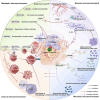Mechanistic Foundations of KRAS-Driven Tumor Ecosystems: Integrating Crosstalk among Immune, Metabolic, Microbial, and Stromal Microenvironment
- PMID: 40485603
- PMCID: PMC12376694
- DOI: 10.1002/advs.202502714
Mechanistic Foundations of KRAS-Driven Tumor Ecosystems: Integrating Crosstalk among Immune, Metabolic, Microbial, and Stromal Microenvironment
Abstract
Kirsten rat sarcoma viral oncogene homolog (KRAS) is the most frequently mutated member of the RAS family of small GTPases (RAS). It affects about one-fifth of cancer cases. The tumor microenvironment (TME) is a multifaceted network of immune cells, metabolites, microbiota, stromal components, and extracellular matrix. It creates a dynamic ecosystem that supports malignant initiation, progression, and therapy resistance through bidirectional crosstalk with tumor cells. Emerging evidence reveals distinct TME landscapes shaped by wild-type versus oncogenic KRAS variants. Additionally, TME rewiring occurs during KRAS-targeted therapies. Deciphering these KRAS-dependent TME architectures and their therapeutic vulnerabilities represents a critical frontier for precision oncology. This review synthesizes key milestones and persistent challenges in KRAS inhibitor development. And it systematically evaluates how KRAS mutations orchestrated immunosuppressive niches, metabolic symbiosis, stromal remodeling, and microbiome dysbiosis, supported by mechanistic insights from preclinical and clinical studies. It further explores therapeutic opportunities arising from targeting TME interactions, including rational combinations of KRAS inhibitors with immune checkpoint blockade, metabolic agents, or microbiota-modulating strategies.
Keywords: KRAS; cancer; immunity; metabolism; microbiota; microenvironment; stroma.
© 2025 The Author(s). Advanced Science published by Wiley‐VCH GmbH.
Conflict of interest statement
The authors declare no conflict of interest.
Figures







Similar articles
-
Interplay between tumor mutation burden and the tumor microenvironment predicts the prognosis of pan-cancer anti-PD-1/PD-L1 therapy.Front Immunol. 2025 Jul 24;16:1557461. doi: 10.3389/fimmu.2025.1557461. eCollection 2025. Front Immunol. 2025. PMID: 40777041 Free PMC article.
-
Targeted degradation of oncogenic KRASG12V triggers antitumor immunity in lung cancer models.J Clin Invest. 2024 Dec 24;135(2):e174249. doi: 10.1172/JCI174249. J Clin Invest. 2024. PMID: 39718828 Free PMC article.
-
Identification and validation of a KRAS-macrophage-associated gene signature as prognostic biomarkers and potential therapeutic targets in melanoma.Front Immunol. 2025 Jun 18;16:1566432. doi: 10.3389/fimmu.2025.1566432. eCollection 2025. Front Immunol. 2025. PMID: 40607411 Free PMC article.
-
[Advances in Immunotherapy of KRAS-mutated Non-small Cell Lung Cancer].Zhongguo Fei Ai Za Zhi. 2025 May 20;28(5):343-352. doi: 10.3779/j.issn.1009-3419.2025.101.08. Zhongguo Fei Ai Za Zhi. 2025. PMID: 40506488 Free PMC article. Review. Chinese.
-
Epidermal growth factor receptor (EGFR) inhibitors for metastatic colorectal cancer.Cochrane Database Syst Rev. 2017 Jun 27;6(6):CD007047. doi: 10.1002/14651858.CD007047.pub2. Cochrane Database Syst Rev. 2017. PMID: 28654140 Free PMC article.
Cited by
-
The Impact of Fusobacterium nucleatum and the Genotypic Biomarker KRAS on Colorectal Cancer Pathogenesis.Int J Mol Sci. 2025 Jul 20;26(14):6958. doi: 10.3390/ijms26146958. Int J Mol Sci. 2025. PMID: 40725204 Free PMC article. Review.
References
-
- a) Scharpf R. B., Balan A., Ricciuti B., Fiksel J., Cherry C., Wang C., Lenoue‐Newton M. L., Rizvi H. A., White J. R., Baras A. S., Anaya J., Landon B. V., Majcherska‐Agrawal M., Ghanem P., Lee J., Raskin L., Park A. S., Tu H., Hsu H., Arbour K. C., Awad M. M., Riely G. J., Lovly C. M., Anagnostou V., Cancer Res. 2022, 82, 4058; - PMC - PubMed
- b) Lee J. K., Sivakumar S., Schrock A. B., Madison R., Fabrizio D., Gjoerup O., Ross J. S., Frampton G. M., Napalkov P., Montesion M., Schutzman J. L., Ye X., Hegde P. S., Nagasaka M., Oxnard G. R., Sokol E. S., Ou S. I., Shi Z., NPJ Precis. Oncol. 2022, 6, 91. - PMC - PubMed
-
- Boriack‐Sjodin P. A., Margarit S. M., Bar‐Sagi D., Kuriyan J., Nature 1998, 394, 337. - PubMed
Publication types
MeSH terms
Substances
Grants and funding
- 82173342/National Natural Science Foundation of China
- 82203015/National Natural Science Foundation of China
- 82373275/National Natural Science Foundation of China
- 82403920/National Natural Science Foundation of China
- 2024JJ6662/Natural Science Foundation of Hunan Province
- 2025JJ20077/Natural Science Foundation of Hunan Province
- 2024RC3042/Science and Technology Innovation Program of Hunan Province
- 2023Q01/Youth Science Foundation of Xiangya Hospital
- GZC20242044/Postdoctoral Fellowship Program of the CPSF
- 2024M753679/China Postdoctoral Science Foundation
- kq2403008/Nature Science Foundation of Changsha
LinkOut - more resources
Full Text Sources
Medical
Miscellaneous
